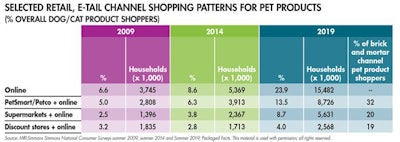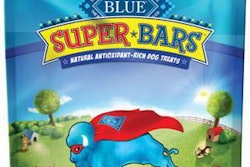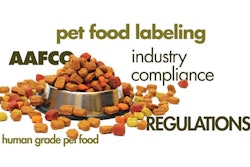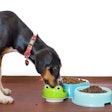
Pet product sales gains and losses over the last decade were increasingly about the internet. The household customer base for pet product e-commerce rose from 3.0 million in 2010 to 15.5 million in 2019 — for a 15% compound annual growth rate (CAGR) over the 10-year period, surging to a superheated 24% CAGR over the most recent five years. The customer base purchasing pet food online increased over 10-fold over the decade, helping to drive 68% sales growth in 2019 for pet food-centric Chewy (owned by PetSmart), as well as recent robust growth for PetSmart.com and Petco.com.
Developments in the mass market channel
The ramifications of pet product e-commerce have never simply been about customer share, however, as reflected in divergent brick-and-mortar sales growth between the mass market and the pet specialty channel. In 2019, in terms of product sales through physical stores, mass retailer revenues grew 6% while sales in the pet specialty channel were generally flat. It might seem paradoxical that mass-market stores are outperforming pet superstores in today’s humanized and pet parent-ized pet industry, where specialty and premium pet products have the sales growth advantage. But two key developments, both intertwined with e-commerce, help explain this outcome.
First, mass retailers now feature very premiumized pet foods, including on-trend mass-market brands such as Rachael Ray Nutrish, Mars’ CRAVE, Walmart’s Pure Balance, channel-straddling Freshpet and formerly specialty channel-only Blue Buffalo and Nutro. The shift of pet food purchasing and sales growth to the internet, which is no respecter of the specialty vs. mass-market divide, undercuts the motivation of specialty brands to maintain that distribution distinction.
Secondly, while e-commerce has clearly grown the overall market and not merely cannibalized sales, there has nonetheless been an element of robbing pet stores to pay Paul. Simmons data show that, at the brick-and-mortar level, pet superstores have taken the most direct hit from e-commerce, based on the number and percentage of their customer base who also buy pet products online.
- The share of overall dog- or cat-owning households that shop for pet products both at PetSmart/Petco and online rose from 6.3% in 2014 to 13.5% as of 2019, thereby growing to account for a third (33%) of PetSmart/Petco customers (see Table 1).
- The share of overall dog- or cat-owning households that shop for pet products at either supermarkets plus also online, or at discount stores plus also online, has also grown, but not as sharply: these customers account for a fifth (19–20%) of current supermarket or discount store pet product customer base. Discount stores, moreover, are doing the better job of keeping their pet product customers in-house.

Table 1: Omnimarket purchasing patterns for pet products continue to grow in popularity as more pet owners look to both online and offline buying options for their needs.
E-commerce effects on pet food brands
Moreover, pet product e-commerce is not only recasting pet food sales patterns across channels, but also impacting which types and brands of pet foods are now in the catbird seat on brick-and-mortar shelves. In one version of everything old being new again, it’s not “natural” pet foods but science- and vet-positioned brands such as Pro Plan (Purina), Royal Canin (Mars) and Hill’s Science Diet (Colgate-Palmolive) that are in the sales growth spotlight, as pet specialty retailers reset their product mix to re-differentiate from the mass market, often (and not always lovingly) at the expense of specialty brands that have crossed over to the mass side.
This trend dovetails with the ever-deepening “omnimarket” relationship between pet product kingpins and vet/pet care services, precisely because hands-on services are the Achilles heel of the internet as a pet product competitor. In another incarnation of everything old being new again, Walmart’s in-store veterinary clinic partnership with PetIQ simultaneously crosses product vs. service and specialty vs. mass-market boundaries, following in the footsteps of PetSmart’s decades-old alliance with Banfield Pet Hospital, whose acquisition by Mars in 2007 fully signaled that omnimarket would become the new normal.
From this perspective, the pinball ricochets of omnimarket competitive strategies have struck hard at the business model of local, independent veterinarians. Traditional veterinarians — in yet another version of the more things change, the more they stay the same — find themselves in the cross-hairs of competition among consumer market giants in the way that traditional pet stores were at the turn of the millennium.
For more on Packaged Facts’ new “U.S. Pet Market Outlook 2020–2021”

















